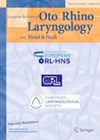
Journal Reviews
Be mindful of exposure
This is a topic which has been highlighted before in the Hearing Research series, as the evidence base regarding the specific impact of acoustic trauma on the auditory system has been expanding regularly in the last few years. This particular...
Third-party disability in cochlear implant users
Hearing loss causes changes for those experiencing it and the people who share in their everyday lives, often referred to as third party disability or caregiver burden. This study emphasises the notion that this phenomenon can be considered a disability,...
Hearing difficulties and memory problems
Since the Lancet Commission report in 2020, we have all been aware that untreated hearing loss is potentially one of the biggest modifiable risk factors for dementia in midlife. Hearing loss is also associated with other risk factors for dementia,...
Cochlear implantation in enlarged vestibular aqueduct patients
In this systematic review, the authors describe the complications and outcomes of cochlear implantation in patients with enlarged vestibular aqueduct (EVA). The authors reviewed five major databases and included 4035 patients from 34 studies. Of these, 853 patients (21.14%) had...
Third-party disability in cochlear implantation
The authors of this study note significant third-party disability experienced by significant others (SO) or communication partners of persons with hearing impairment (PHI). The study explored contextual and psychosocial factors for successful auditory rehabilitation, advocating for the importance of including...
Make food thy medicine!
This is a useful paper emphasising how diet affects health and various ENT conditions. We have known for many years the power of food as medicine. We also know that what we eat can affect our bodies in multiple ways...
Small but significant
These authors try to circumnavigate the conundrum of what is influenced by what. For something so small, the impact of the Stria Vascularis cannot be understated. The difficulty in reviewing the influence of loop diuretics or aminoglycosides on the Stria...
Moving towards implanting children below 12 months of age
Newborn hearing screening has ensured that deaf infants are identified soon after birth so that habilitation can begin as early as possible. Cochlear implantation is a key component of early intervention for some children, but it is often not performed...
Robotic insertion of electrode array in cochlear implantation
Cochlear implants (CIs) are commonly used for profound bilateral hearing loss. They have specific national guidance for their insertion, however patients with a substantial residual acoustic hearing are potential CI candidates. Preservation of this residual hearing can be sought with...
Which scan for children with bilateral sensorineural hearing loss? Keeping the debate going…
There have been years of debate about the appropriate imaging strategy for children with bilateral sensorineural hearing loss. For those children undergoing cochlear implant surgery, CT may provide some assistance to surgical planning, although this is not necessary in children...
Identifying congenital CMV: the screening debate
Congenital cytomegalovirus (cCMV) is a significant global public health burden and is the biggest non-genetic cause of childhood hearing loss, as well as being an important cause of neurodevelopmental delay. Despite a study concluding that there was not enough evidence...
Smartphone hearing test
Our Editors’ Choice for this edition reviews an article looking at the use of a smartphone app for hearing screening. We have all had to integrate telehealth into our practice to some extent recently and this paper examines a teleaudiology...
















